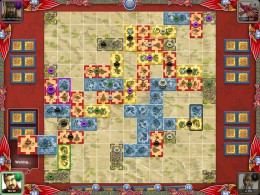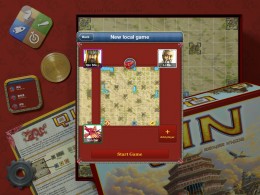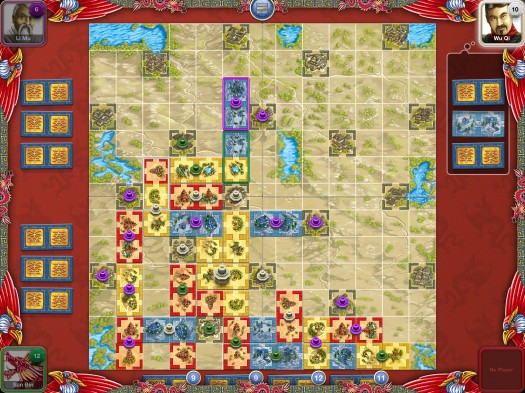 When I first got my iPad, I hadn’t been playing physical board games for long. Sure, I played Monopoly and its ilk as a kid, but it wasn’t until I got into things like Arkham Asylum and Carcassone as an adult that I really understood the appeal. Before that, they seemed slow, finicky and sort of lame. Afterwards, they seemed slow, finicky and kind of fantastic. The iPad let me dream of board games that kept the quality and ditched all those slow, finicky bits.
When I first got my iPad, I hadn’t been playing physical board games for long. Sure, I played Monopoly and its ilk as a kid, but it wasn’t until I got into things like Arkham Asylum and Carcassone as an adult that I really understood the appeal. Before that, they seemed slow, finicky and sort of lame. Afterwards, they seemed slow, finicky and kind of fantastic. The iPad let me dream of board games that kept the quality and ditched all those slow, finicky bits.
For the most part, that’s come true. Board game fans are already spoiled for choice on iOS, and a lot of that choice is excellent. Up until now, though, we’ve been getting a slow trickle of ports of long-standing and popular tabletop titles. Reiner Knizia’s Qin ($4.99) throws down the gauntlet to game designers by landing simultaneously on the App Store and on retail shelves. The only problem? I can’t imagine why I’d possibly want a boxed version when the iPad release is this well-made.
Putting the packaging aside for a minute, Qin is an interesting game. It’s a relatively straightforward tile-laying title for two to four players about claiming territory—think Carcassone, or Tigris & Euphrates for the Knizia fans in the room. Just don’t try to play the game like the former as I once tried: claiming up the largest pieces of land you can is the quickest way to lose.
Qin’s boards are littered with unclaimed villages and empty space. You get a random selection of 3 tiles, each with two colored province spaces on them. There are three colors, and the tiles are split between doubles and combinations. Your job is to stick at least two matching colors together and lay down a pagoda to mark the completed province as your own. That’s actually the majority of the game right there—it ends when a player puts down his or her last pagoda.
 The devil’s in the details, of course. Founding a province is a simple task. All you need is that two-tile match somewhere that connects to another province. Expanding a province lets you double up your pagodas, but only once you reach five tiles. That gives you a major province, and no matter how many more tiles you add to those five, it will only ever give you two pagodas.
The devil’s in the details, of course. Founding a province is a simple task. All you need is that two-tile match somewhere that connects to another province. Expanding a province lets you double up your pagodas, but only once you reach five tiles. That gives you a major province, and no matter how many more tiles you add to those five, it will only ever give you two pagodas.
The villages that already exist on the board are tasty to capture, because they’re yours automatically if you put a province down beside them: two pagodas for the price of one. That’s where things start to get tricky. Villages are pretty big, and more than one player can butt up against them. They can be conquered by whoever has the most adjacent pagodas, leaving them extremely vulnerable to switching hands.
Then there’s the ultimate coup: absorbing an opponent’s province. If a player joins separate provinces of the same color with different owners, the one with the most spaces in the original province wins. This is a tricky maneuver to pull off: not only do you risk miscounting and giving away your own territory, but attempting to plan out an absorption can leave you vulnerable to attack elsewhere on the board.
 Games of Qin are necessarily pretty quick. There is a limit to the space on the board and the tiles in the pot, so adding more players doesn’t make things take much longer. It just makes them infinitely more complicated. With such simple rules and only a little luck at play, the game is quite cerebral for something so quick. It’s definitely a thinker’s game.
Games of Qin are necessarily pretty quick. There is a limit to the space on the board and the tiles in the pot, so adding more players doesn’t make things take much longer. It just makes them infinitely more complicated. With such simple rules and only a little luck at play, the game is quite cerebral for something so quick. It’s definitely a thinker’s game.
As you’ve probably picked up with all this talk of provinces and pagodas, there’s a theme at play in Qin: China, more than 2000 years back. That’s purely set dressing. Qin could easily be an utterly abstract game of colored tiles and markers without losing a thing. Still, it’s elegant set dressing, part of an overall impressive presentation. The menu, for example, looks like the contents of the box have spilled perfectly across the screen. The in-game interface is clean and functional while still including some lovely ornamental elements.
Best of all, the design is true to the board game. I’m fine with iOS board games that let go of the skueomorphic elements of the physical game, but if I plan to play with others I prefer they’re left alone. There’s nothing that really replaces that feeling of sitting around a board with a pile of tiles, and dolling it up with animated nonsense doesn’t really add to the multiplayer experience.
Speaking of the multiplayer experience, that’s where Qin the iOS title really steps ahead of Qin in a box. Yeah, I’d love to be able to get together with three friends and pull out a board game every week, but that’s not always the easiest thing to make happen. This app gives you all the options you could ask for. You can play through Game Center with up to three others. You can play hot seat with any combination of human and AI players. Or you can chuck the others and just fight the AI. This is more satisfying than it has any right to be, with opponents that range between pure punishment and only a little cruelty.
Despite its fairly limited strategic options, Qin is a solid board game. It will certainly appeal to fans of abstract, thoughtful games, and its simplicity is rather elegant. Still, even at higher levels it lacks staying power. Two boards might seem a luxury for a physical release, but the game begs for a bit of variety in the long run. The iPad release is excellent, but even in a box I fear this game would eventually gather dust. On iOS, it runs the risk of getting lost among the competition. It’s great while it lasts, on the other hand, and if that’s good enough for you then Qin is an easy game to recommend.

